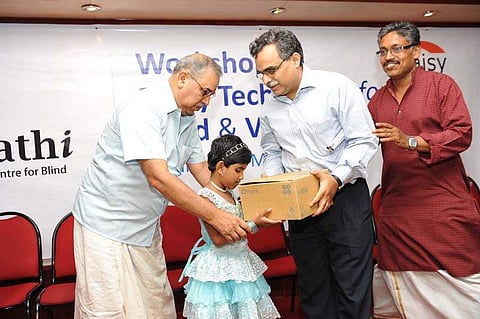

Almost a decade ago, a visually-impaired individual approached Ram Kamal Manoj to get his help to learn how to use a computer. At the time, there were barely any computer training centres in the state and there was certainly no platform where a blind man could learn. Ram Kamal, an expert in the field, decided to lend a hand. When he saw the progress that his first student was able to make, he realised how vital technology could be in making their lives easier.
In 2011, he set up Chakshumathi Assistive Technology and Empowerment Centre For the Blind. He says, “It started as a training centre where we empowered every blind student who approached us. I emphasise on ‘student’ because we only work with students, not with anyone older because our slogan is ‘It is easier to build stronger children than repair broken men’.”
Children from kindergarten and upwards attend Chakshumathi. They are taught to use technology through their mobile phones and laptops. Every form of visual impairment, conditions like dyslexia and autism and a range of learning disabilities, including ADHD, can lead to a student falling under the spectrum of print disability. The organisation works with any student who falls under this by empowering them with voice command and dictation technology.
Ram Kamal says, “Despite common belief, very few people actually know Braille. In Kerala, there are 55,000 blind children who attend school who have print disabilities. Only around 2,000 to 2,500 children go to blind schools where they are tortured to learn Braille. Braille can’t do anything when it comes to higher education, science education or anything of value. After you earn a degree, it will not help you in any way because you are still not employable. When you use technology, the child is employable from day one because he knows how to write.”
The Chakshumathi training programme is very simple. Students are taught how to use computers, mobile phones and other smart devices. They follow a syllabus from first to tenth standard, based on Computer Programming. From tenth standard onwards, AI is introduced into the syllabus. They are taught everything including Junior Coding, Junior Python and Junior Java before graduating to the senior levels of the same. Currently, 650 students are enrolled from 18 countries.
“My children are able to design their own games — they are just in the second or fourth standard!” says a proud Ram Kamal, “We are creating new methodologies and global standards for inputting science and mathematics digitally. Why haven’t the Central and State syllabi introduced digital options for print-disabled students? A child who gets an A with the help of a scribe is still demotivated because they cannot experience it for themselves. Our students are using their own computers in schools. The efforts are their own, their scores are also entirely their own.”
